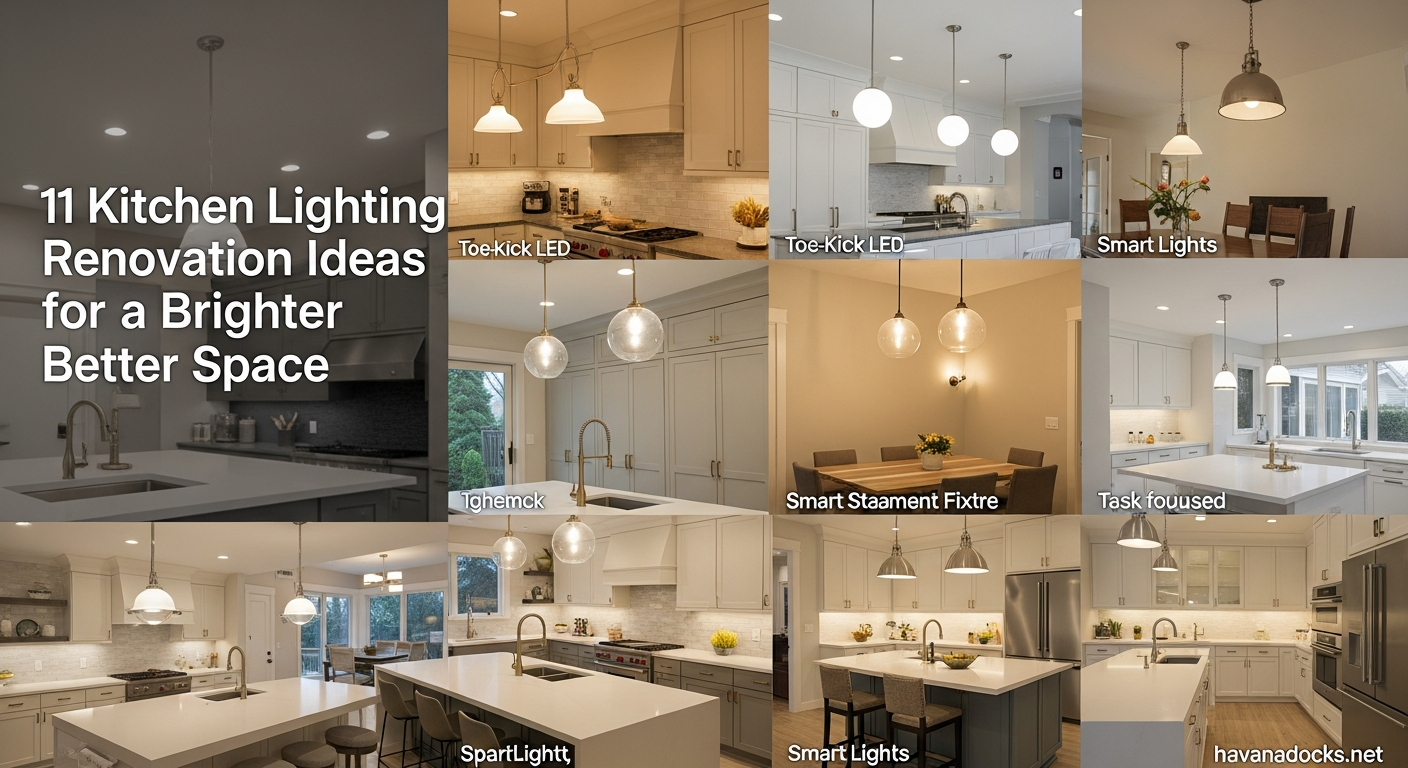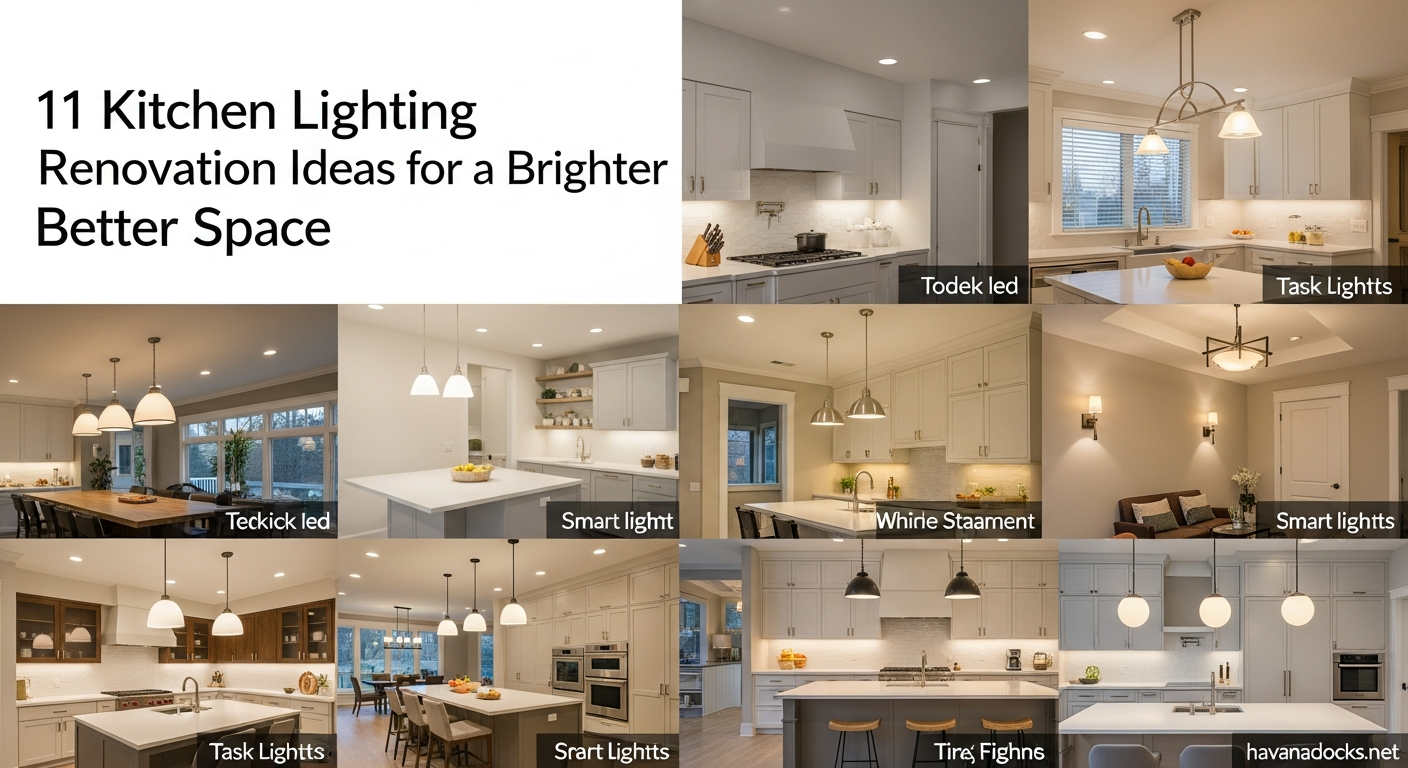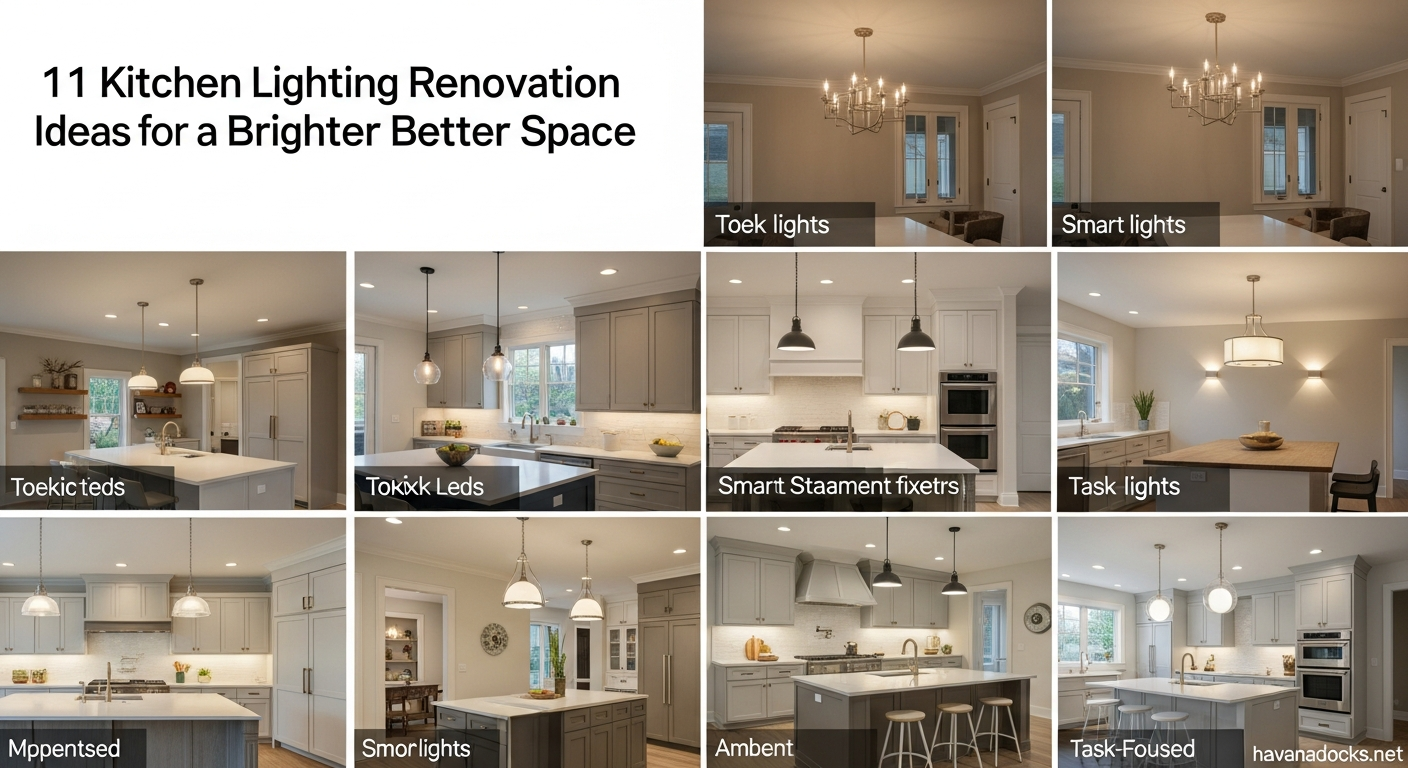1. Understanding the Importance of Kitchen Lighting
11 Kitchen Lighting Renovation – Proper kitchen lighting is essential for both functionality and aesthetics. It allows you to perform tasks safely and efficiently, provides ambient illumination, and highlights the room’s design elements. A poorly lit kitchen can not only be frustrating but also potentially dangerous, increasing the risk of accidents while preparing food. Investing in a thoughtful kitchen lighting renovation is an investment in your safety, comfort, and overall well-being.

The Three Layers of Kitchen Lighting
Effective kitchen lighting renovation projects consider these three distinct layers:
- Ambient Lighting (General Lighting): This provides overall illumination for the entire kitchen, creating a comfortable and inviting atmosphere. It’s often achieved with overhead fixtures like recessed lighting, pendant lights, or chandeliers.
- Task Lighting: Focused light sources that illuminate specific workspaces, such as countertops, sinks, and cooking areas. Under-cabinet lighting, pendant lights over the island, and spotlights serve as effective task lighting.
- Accent Lighting: Used to highlight architectural features, artwork, or decorative elements within the kitchen. Examples include spotlights on artwork, in-cabinet lighting, or strip lighting under the toe kicks.
2. Idea 1: Recessed Lighting – A Classic and Versatile Choice
Recessed lighting, also known as pot lights, is a popular choice for kitchen lighting renovation due to its clean, minimalist look and its ability to provide even ambient lighting. They are installed flush with the ceiling, minimizing visual clutter and blending seamlessly with any kitchen design.
Benefits of Recessed Lighting
- Even Illumination: Distributes light evenly across the entire kitchen, eliminating dark spots and creating a bright and welcoming atmosphere.
- Discreet Design: Tucks neatly into the ceiling, making it a visually unobtrusive option.
- Versatility: Compatible with a variety of bulb types, including LED, halogen, and incandescent. LED options are highly recommended for energy efficiency.
- Layering Potential: Easily combined with other lighting types, such as pendant lights and under-cabinet lighting, for a layered lighting scheme.
Considerations for Recessed Lighting
- Placement: Careful placement is crucial. Consult with a lighting professional to determine the optimal spacing and number of fixtures needed for your kitchen’s size and layout. Focus on areas where task lighting is needed, such as countertops and the sink.
- Dimmers: Installing recessed lights with dimmers allows you to adjust the brightness level according to your needs and preferences, adding versatility to your kitchen lighting renovation.
- Insulation Contact (IC) Rating: Ensure that the recessed lighting fixtures have an IC rating if they will be installed near insulation. This rating indicates that the fixtures are safe to be in direct contact with insulation without posing a fire hazard.
3. Idea 2: Pendant Lights – Adding Style and Task Lighting
Pendant lights are suspended from the ceiling and provide both ambient and task lighting. They can serve as a focal point in your kitchen and add a touch of personality with their diverse range of styles, sizes, and materials. Pendant lights are a fantastic addition to any kitchen lighting renovation project.
Using Pendant Lights Effectively
- Over Kitchen Islands: Pendant lights are commonly hung over kitchen islands to provide task lighting for food preparation and dining. Choose pendants that complement the island’s size and shape.
- Above Sinks: A single pendant light over the sink can provide focused illumination for washing dishes and other tasks.
- In Nooks and Alcoves: Use pendant lights to create cozy and inviting reading nooks or breakfast areas within your kitchen.
- Height Considerations: Ensure that pendant lights are hung at the appropriate height to avoid obstructing views or causing glare. The general rule of thumb is to hang pendant lights 30-36 inches above the countertop.
Different Pendant Light Styles
- Mini Pendants: Small and delicate, ideal for grouping together over a kitchen island or breakfast bar.
- Glass Pendants: Offer a clean and modern look, allowing light to shine through and illuminate the space.
- Metal Pendants: Provide a more industrial or contemporary feel, adding a touch of sophistication to your kitchen lighting renovation.
- Fabric Pendants: Soften the look of the kitchen and add a touch of warmth and texture.
4. Idea 3: Under-Cabinet Lighting – Illuminating Work Surfaces
Under-cabinet lighting is a crucial element of any effective kitchen lighting renovation strategy. It provides focused task lighting on countertops, making food preparation and other activities easier and safer.
Benefits of Under-Cabinet Lighting
- Eliminates Shadows: Brightens up countertops and reduces shadows, improving visibility and reducing eye strain.
- Increases Safety: Makes it easier to see what you’re doing while using knives and other kitchen tools, reducing the risk of accidents.
- Energy Efficient: LED under-cabinet lighting is highly energy efficient, saving you money on your electric bill.
- Easy Installation: Available in a variety of formats, including tape lights, puck lights, and linear fixtures, making installation relatively simple.
Types of Under-Cabinet Lighting
- LED Tape Lights: Flexible strips of LED lights that can be easily cut to the desired length and adhered to the underside of cabinets. These provide a continuous, even glow.
- LED Puck Lights: Small, round lights that can be surface-mounted or recessed into the underside of cabinets. They provide more focused beams of light.
- Linear Fixtures: Longer, rectangular fixtures that provide broad, even illumination across the entire countertop.
5. Idea 4: Track Lighting – Flexible and Adjustable
Track lighting consists of a track that is mounted to the ceiling, with multiple light heads that can be positioned and adjusted to direct light where it’s needed most. This flexibility makes track lighting an excellent choice for kitchen lighting renovation projects, especially in kitchens with unique layouts.
Advantages of Track Lighting
- Adjustable Light Direction: The light heads can be rotated and tilted to target specific areas or features.
- Versatile Placement: The track can be installed in a straight line, an L-shape, or even a curved shape, adapting to the unique features of your kitchen.
- Spotlighting Capabilities: Ideal for highlighting artwork, architectural details, or specific areas of the kitchen.
- Modern Aesthetic: Track lighting offers a contemporary and industrial feel that complements modern kitchen designs.
Considerations for Track Lighting
- Track Length: Choose a track length that is appropriate for the size of your kitchen. Longer tracks can accommodate more light heads, providing more comprehensive illumination.
- Light Head Style: Select light heads that complement your kitchen’s design and provide the desired level of illumination. Options include spotlights, floodlights, and pendant lights.
- Dimmability: Consider installing a dimmer switch that is compatible with your track lighting system to control the brightness level and create different moods.
6. Idea 5: Chandelier – A Statement Piece
A chandelier can be a stunning addition to your kitchen, adding a touch of elegance and sophistication. While traditionally associated with dining rooms, chandeliers can also work beautifully in kitchens, especially above islands or breakfast nooks. This bold move helps define the space during your kitchen lighting renovation.
Choosing the Right Chandelier
- Size: Select a chandelier that is proportionate to the size of your kitchen. A large chandelier can overwhelm a small kitchen, while a small chandelier can get lost in a large kitchen.
- Style: Choose a chandelier that complements your kitchen’s overall design style. Options range from traditional crystal chandeliers to modern geometric chandeliers.
- Placement: The ideal placement for a chandelier in the kitchen is above the island or a breakfast nook. Ensure that the chandelier is hung at the appropriate height to avoid obstructing views or creating glare.
- Dimmability: A dimmable chandelier provides versatility and allows you to adjust the brightness level to create different atmospheres.
7. Idea 6: Smart Lighting – Control at Your Fingertips
Smart lighting systems allow you to control your kitchen lights remotely using your smartphone or voice commands. This modern convenience can be a game-changer in your kitchen lighting renovation, allowing you to customize the lighting to suit your needs and preferences.
Benefits of Smart Lighting
- Remote Control: Turn lights on and off, dim them, or change their color temperature from anywhere using your smartphone or a smart home assistant.
- Scheduling: Set schedules for your lights to turn on and off automatically, saving energy and providing added security.
- Voice Control: Control your lights with voice commands using a smart home assistant like Amazon Alexa or Google Assistant.
- Customization: Adjust the color temperature of your lights to create different moods, from warm and inviting to cool and energizing.
- Energy Savings: Many smart lighting systems offer energy-saving features, such as motion sensors and automatic dimming, which can help you reduce your energy consumption.
Types of Smart Lighting Options
- Smart Bulbs: Replace your existing light bulbs with smart bulbs that can be controlled via a smartphone app.
- Smart Switches: Replace your existing light switches with smart switches that can be controlled remotely.
- Smart Hubs: A smart hub connects all your smart lighting devices and allows you to control them from a single app. Popular options include the Philips Hue Bridge and the Samsung SmartThings Hub.
8. Idea 7: Natural Light Enhancement – Bringing the Outdoors In
While artificial lighting is essential, maximizing natural light should also be a priority in your kitchen lighting renovation. Natural light can enhance the brightness and spaciousness of your kitchen, creating a more cheerful and inviting atmosphere.
Strategies for Enhancing Natural Light
- Larger Windows: Consider replacing smaller windows with larger ones to allow more natural light to enter the kitchen.
- Skylights: Skylights are an excellent way to bring natural light into kitchens that lack exterior walls.
- Light-Colored Surfaces: Use light-colored paint, countertops, and backsplashes to reflect natural light and brighten up the space.
- Mirror Placement: Strategically place mirrors to reflect natural light and create the illusion of more space.
- Clear Doors: Replace solid doors with glass doors to allow more natural light to flow between rooms.

9. Idea 8: Toe-Kick Lighting – A Subtle and Stylish Accent
Toe-kick lighting involves installing LED strip lights under the base cabinets, near the floor. This subtle and stylish accent lighting can add a touch of sophistication to your kitchen lighting renovation, while also providing a functional benefit.
Benefits of Toe-Kick Lighting
- Subtle Illumination: Provides a soft, ambient glow that illuminates the floor and creates a welcoming atmosphere.
- Night Lighting: Can be used as a night light, providing a soft glow that makes it easier to navigate the kitchen in the dark.
- Added Style: Enhances the overall aesthetic of the kitchen, adding a touch of modern elegance.
- Safety: Provides subtle illumination that can help prevent tripping hazards in the dark.
Installation Tips for Toe-Kick Lighting
- LED Strip Lights: Use LED strip lights for a continuous, even glow.
- Concealed Wiring: Conceal the wiring behind the base cabinets for a clean and seamless look.
- Dimmable: Install a dimmer switch to control the brightness level and create different atmospheres.
10. Idea 9: In-Cabinet Lighting – Showcasing Your Treasures
In-cabinet lighting involves installing lights inside your cabinets to illuminate your dishes, glassware, and other items. This can enhance the visual appeal of your kitchen and make it easier to find what you’re looking for. Integrating this into your kitchen lighting renovation can make a significant difference.
Types of In-Cabinet Lighting
- Puck Lights: Small, round lights that can be surface-mounted or recessed into the cabinet.
- LED Strip Lights: Flexible strips of LED lights that can be easily adhered to the inside of the cabinet.
- Shelf Lighting: Lights that are integrated into the shelves of the cabinet, providing even illumination.
Benefits of In-Cabinet Lighting
- Enhanced Visibility: Makes it easier to find items inside the cabinet, especially in dark corners.
- Showcasing Your Treasures: Highlights your dishes, glassware, and other collectibles.
- Creating Ambiance: Adds a touch of warmth and elegance to your kitchen.
Choosing the Right In-Cabinet Lighting
Consider the size and style of your cabinets when choosing in-cabinet lighting. Puck lights are ideal for smaller cabinets, while LED strip lights are better for larger cabinets. Choose a light source that complements your kitchen’s overall design.
Installation Tips
Ensure that the wiring is properly concealed and that the lights are securely mounted inside the cabinet. Consider using battery-operated lights for a simpler installation.

11. Idea 10: Statement Fixtures – Express Your Style
Don’t be afraid to incorporate bold and unique lighting fixtures that reflect your personal style. Statement fixtures can add personality and character to your kitchen, making it truly your own. From intricate chandeliers to avant-garde pendants, these additions elevate your kitchen lighting renovation.
Finding the Perfect Statement Piece
- Consider your kitchen’s style: Choose fixtures that complement the overall design aesthetic of your kitchen.
- Think about scale: Ensure that the fixtures are appropriately sized for the space. Overly large fixtures can overwhelm a small kitchen, while overly small fixtures can get lost in a large kitchen.
- Don’t be afraid to experiment: Try different styles and materials to find something that speaks to you.
- Visit lighting showrooms: Explore different lighting options in person to get a better sense of their size, style, and quality.
12. Idea 11: Color Temperature – Setting the Mood
Understanding Color Temperature
- Warm Light (2700K-3000K): Creates a cozy and inviting atmosphere. Ideal for ambient lighting in dining areas and breakfast nooks.
- Neutral Light (3500K-4000K): Provides a balanced and natural light. Suitable for task lighting in kitchens and bathrooms.
- Cool Light (5000K-6500K): Creates a bright and energizing atmosphere. Best for task lighting in workspaces and utility areas.
Choosing the Right Color Temperature
Consider the function of each area in your kitchen when choosing the color temperature of your lights. Use warm light in areas where you want to create a relaxed atmosphere, such as dining areas and breakfast nooks. Use neutral or cool light in areas where you need bright, focused light, such as countertops and cooking areas.
Conclusion
A kitchen lighting renovation can significantly enhance the functionality, aesthetics, and overall ambiance of your home. By incorporating these 11 inspiring ideas, you can create a brighter, more inviting, and more efficient kitchen that you’ll love spending time in. Remember to consider the three layers of lighting – ambient, task, and accent – to create a well-balanced and functional lighting scheme. Don’t be afraid to experiment with different styles, materials, and technologies to find the perfect lighting solutions for your kitchen’s unique needs and your personal preferences. By carefully planning and executing your kitchen lighting renovation, you can transform your kitchen into the heart of your home.





